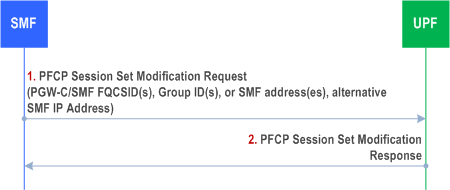Content for TS 23.527 Word version: 19.0.0
4.7 Restoration of PFCP sessions associated with a specific FQ-CISD, Group ID or SMF IP Address
4.7.1 General
4.7.2 Allocation of Group Id or FQ-CSID to a PFCP session
4.7.3 Restoration of PFCP sessions associated with an FQ-CSID, Group ID or SMF IP Address
...
...
4.7 Restoration of PFCP sessions associated with a specific FQ-CISD, Group ID or SMF IP Address |R17| p. 14
4.7.1 General p. 14
To reduce signalling latency and achieve a better load balancing among SMFs in a SMF Set when it is deployed, an SMF in a SMF Set and a UPF may support the procedures specified in this clause. These procedures enable an SMF from the same set to request UPF to move PFCP sessions associated with certain FQ-CSIDs (when partial failure handling is supported as specified in clause 4.6), Group IDs or SMF IP addresses, to (another) SMF(s) in the set proactively, without causing massing signalling (per PFCP session) towards UPF(s).
4.7.2 Allocation of Group Id or FQ-CSID to a PFCP session p. 14
To optimize the resource utilization for PFCP session(s), e.g. to meet different traffic requirements for different APNs/DNNs and/or DCNs/Network Slices, and also to facilitate moving a (sub)set of PDN connections/PFCP sessions among an SMF set, e.g. for a partial or complete SMF failure or a scale-in operation, an SMF in a SMF Set may:
- allocate a globally unique Group Id in the PFCP Session Establishment Request message for a PFCP session during a PFCP session establishment procedure and update the Group Id, if necessary, in subsequent PFCP Session Modification Request messages (see also clause 5.22.4 of TS 29.244).
4.7.3 Restoration of PFCP sessions associated with an FQ-CSID, Group ID or SMF IP Address p. 14
When there is a need to change the SMF controlling certain PFCP sessions, e.g. when a partial or complete failure takes place, the SMF (either the SMF serving the PFCP sessions or another SMF in the same Set taking over the control of the PFCP sessions) may send a PFCP Session Set Modification Request message to the UPF(s) to request the UPF(s) to send subsequent PFCP Session Report Request messages to the alternative SMF (as indicated in the Alternative SMF IP Address IE) for the PFCP sessions which are associated with the FQ-CSID(s) or Group ID(s), or which have their CP F-SEIDs containing the SMF IP Address as shown in Figure 4.7.3-1.
The SMF may instruct the UPF to move sessions associated with different SMF FQ-CSIDs, Group Ids or SMF IP addresses, to different SMF addresses.
